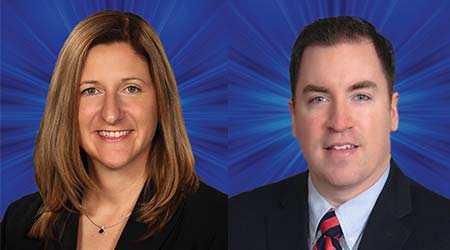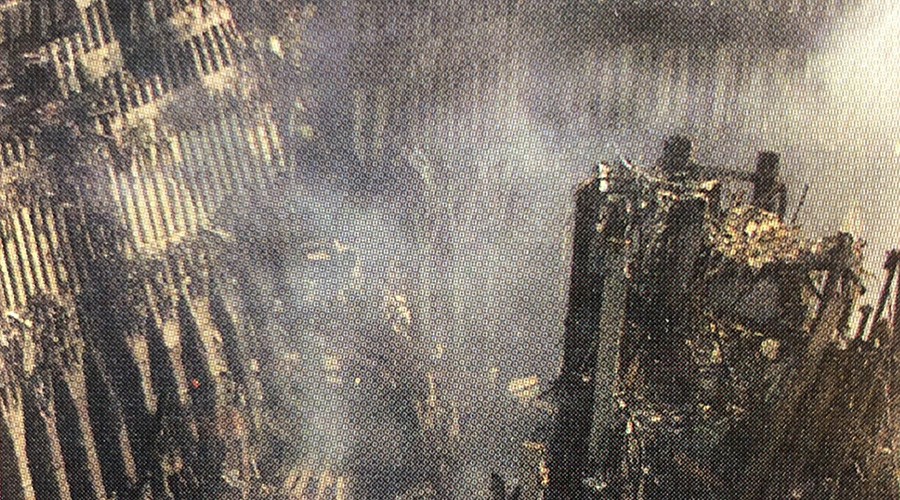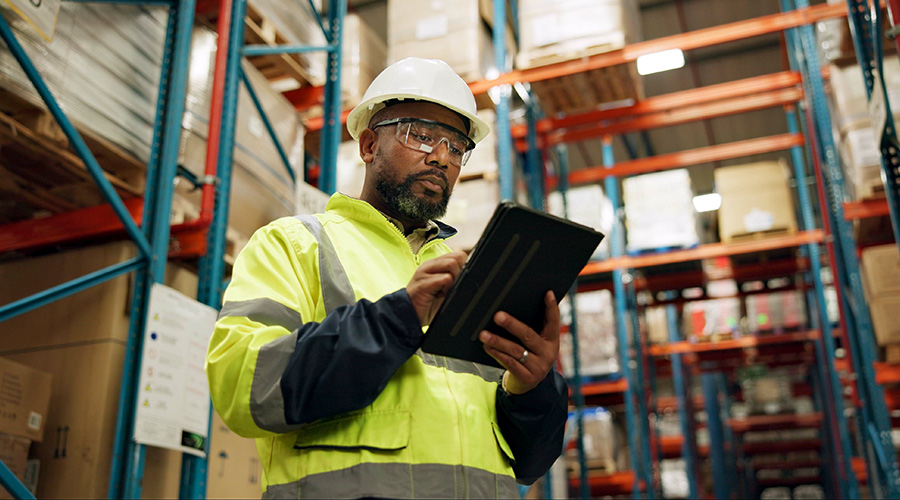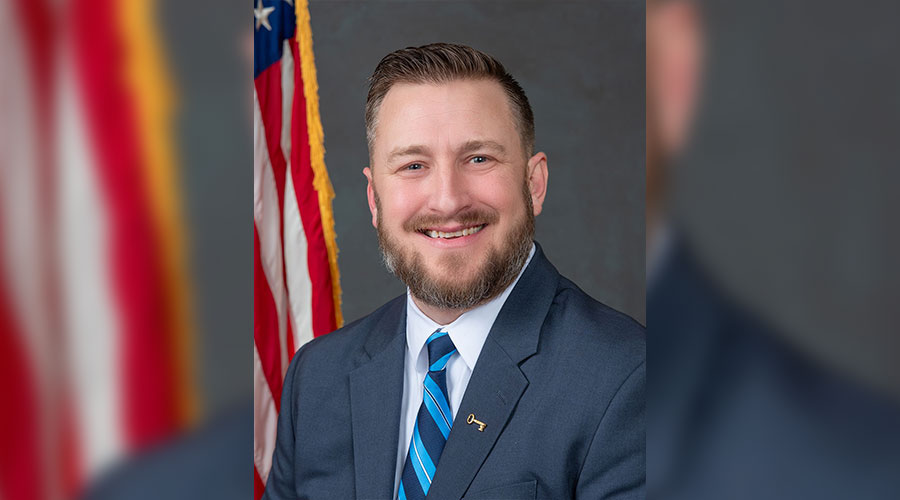 (L to R) Jennifer DuPlessis, Executive Director of Operations, Wylie (Texas) Independent School District, Brian Robertson, Senior Project Manager, Facilities Engineering, Princeton University.
(L to R) Jennifer DuPlessis, Executive Director of Operations, Wylie (Texas) Independent School District, Brian Robertson, Senior Project Manager, Facilities Engineering, Princeton University.Buy Smart: Roundtable: Managers Discuss Strategies and Tactics to Help Specify Products That Can Benefit a Facility
By Dan Hounsell, Editor-in-Chief
OTHER PARTS OF THIS ARTICLEPt. 1: This Page
Among the most time-consuming and complex duties for maintenance and engineering managers is specifying products and technology for institutional and commercial facilities. Whether the materials support technicians’ daily activities or go into new construction or upgrade projects, managers must make decisions that meet a host of demands related to cost, reliability, serviceability and sustainability. Their decisions go a long way in determining the success of their departments and the work they perform.
What is your role in specifying and purchasing products and technology?
DuPlessis: I would describe my role mostly as an approver. I’m more involved in purchases that are really critical or strategic to what we’re trying to accomplish as a department — critical software programs or any standardization that we want to do for things like HVAC controls. I like to get a lot of input from the people who deal with it every day. I get a lot of input from the team, even on those decisions. For the day-to-day things, I put a lot of trust in the people who deal with it. So generally we have conversations related to my purchasing philosophy, and I do a check to make sure we’re all on the same page.
Robertson: I oversee the campus-wide LED lighting upgrade program. Within that role, there’s everything from negotiating pricing to reviewing alternate design lighting decisions on new construction projects. I purchase about 70 percent of all lighting on campus. Since the start of upgrades in July 2014, I have purchased over 100,000 LED lighting products. The other role I have is working with many LED lighting manufacturers on beta-product testing and pilot programs. We’ve tried several products at the university to see how they hold up. We study application logistics and get user feedback from faculty and students. I’ve also had the opportunity to research and help develop new LED products evaluating them in a variety of facility spaces.
What are the most important factors in your specification and purchasing decisions?
Robertson: Energy-saving opportunities are the foundation of the program, so ROI is important. What plays a big part in ROI is first cost and performance. We need products that offer great performance and have a reasonable first cost while meeting aesthetic requirements. The second factor is the warranty. We look at exclusions because everything typically is a limited warranty. Also, lead times. How fast can we get replacement products if we have a warranty claim? Product availability is a big thing for us. Because this (LED upgrade) program is very fast paced. We need to make sure we specify the right product the first time and that it is available to arrive in a timely manner to meet demanding project schedules.
DuPlessis: We always want to have a reasonable first cost, but I do look at the product or the solution from a total life-cycle perspective. How much is it going to cost us to maintain it? How quickly will we need to replace it? I also need to know if it’s going to help us achieve our strategic goals. Is it something we’re going to be able to utilize a lot and successfully? And then serviceability. Am I going to be able to get support if I need it to keep that system or product up and running? Life-cycle cost and sustainability to me are the same thing, or at least interrelated. Part of sustainability to me is that it is cost-effective over the long term.
How has the influence of sustainability in product selection changed?
DuPlessis: Sustainability is even more important now than it was 15 years ago when we were first starting to talk about it. Our understanding of sustainability has changed. When green products were new, people were wowed by new jargon and new ideas that may or may not have been things we could actually use and sustain, so they were not actually sustainable products. We’ve become more sophisticated buyers in trying to find solutions that truly are sustainable. Some of the things that manufacturers talk about now, like biomimicry, are getting us back to focusing on what really does make sense over the long-term life of a product and not just that it has really neat green marketing.
Robertson: Right now, it should be the most important topic in the LED lighting market, in my opinion. This will become a major issue that the industry as a whole is not addressing. We’ve taken a step back and started really looking at product sustainability. Our concern is that if we put in these new LED fixtures, in 10 years, are we going to have to replace them all? If we have one failed fixture that is discontinued or has changed specification, how will we match the existing fixtures both aesthetically and in lumen output. There is going to be major up-front capital costs to replace all fixtures again or sacrifices to install small amounts of replacements because some fail that do not perfectly match. Facilities are accustomed to legacy products, where if a component failed on a fixture, you could replace it, whether it be the ballast, or the lamp. That is no longer is the case. We’re finding that out, even with warranty claims. When we have a problem with one (LED) fixture, and the manufacturer won’t send parts to fix that fixture. They send you a brand new fixture, which at the onset of the program was appealing. We now see that as the wrong approach because the manufacturer informs us that to replace that one failed fixture in a room, we will have to wait six to eight weeks for that new product to be delivered.
What are your biggest challenges in successful product specification? How have you tried to address these challenges?
Robertson: Since we’re such a large institution with a variety of facility types, one challenge is accommodating personal preferences. The campus has standards for color temperature and color rendering index and things like that, depending on the use of the space. What we don’t really look at that often is the people’s preferences in their offices and spaces in general. The solid-state lighting industry originated based on energy-saving principals, so the industry markets the most energy-efficient products out there. They’re not always focused on correct color temperature or occupant comfort. As a result, you could easily end up with a project that does not have a positive outcome. That has been a challenge for us — ensuring we take into consideration all of the product specifications related to the application.
DuPlessis: My answer is related to cost, but it’s not simply cost. We’ve been working in facilities maintenance long enough that we’ve learned how to talk about what we do in a way that might get us the funding we need because we’ve attached it to the strategic goals. The challenge we have is balancing things we need from a maintenance perspective, such as standardization and things we can maintain fairly simply and cost-effectively. A lot of times that drives us toward selecting one or two products or services that serve us best. We know that they do, but at the same time, we don’t want to necessarily single-source everything we do.
What is one instance in which product research led to tangible benefits from the products you specified?
DuPlessis: We single-sourced from a particular vendor for building automation. They have become a strategic partner and helped in a lot of ways, but in the past we did not manage that very successfully in terms of what our expectations were. In this particular case, we looked at other providers to basically provide two different options from two different vendors. We were able to not only bring in a new entrant and some competitive pricing. We also were able to look at our existing partner and do some new things. It turns out they had some new things that we just had never asked for. We were able to build a better relationship with that vendor, as well as introduce another one for some competitive pricing.
Robertson: We had a classroom space in one of our buildings that required dimming. It was a hard ceiling, so there were surface-mounted fixtures, and there was suspected asbestos in the ceiling. We couldn’t disturb the fixtures, or we’d have to abate the space. To modify the fixtures to be dimmable without running wire, we worked with a manufacturer that created a product that worked off an existing standard ballast. The lamps dimmed wirelessly through a (radio frequency) wallswitch. The fixtures were now dimmable.
Describe a specification decision that did not work the way you intended.
Robertson: We have a large warehouse space that is used by our theater group to create their production sets. Because most of the theater lighting is still high color rendering index incandescent with warmer color correlated temperature (CCT), the production department wanted to be sure that the sets they were designing would look the same under the theatre lighting in real time. We needed to upgrade the lighting in this space to be energy efficient, and we had to look at high-bay options. The only product we could find that would provide comparable foot candles with the warmest CCT was a 3,000 kelvin product. After we installed it, the occupants weren’t truly happy with the outcome. They thought the LED lighting was too cool, so we had to figure out a way to put in a warmer product. We modified the existing fixture by using a color-correcting gel that we put in between the lens and the LED boards. This solution provided the warmer light they required, but the downside is that it cut some of the lumen output. To remedy this, we had to install a few extra fixtures to compensate for the light loss due to installing the gels. We were fortunate to be able to cover this with our contingency.
DuPlessis: I had specified a product because we were looking at a grant, and I was very excited to get this grant. It was related to energy efficiency and sustainability. At the time, I had a portfolio of buildings with hundreds of portable classrooms. In doing audits, I discovered that they were running when nobody was occupying the buildings. Our challenge was to find a solution to integrate the massive number of portable buildings. I did some research to find a solution that, frankly, was ahead of its time. I knew what I wanted, and it didn’t really exist. I wanted something that was IP-based but that could be used through some type of dashboard, knowing that I had hundreds of these things and I was not going to be able to dial into individual websites for this type of thing. I ended up going with a company that was trying to be on the cutting edge and do that. I did verify that they did that and that they had a dashboard. We discovered that it was a poor solution for the type of facility we had. It didn’t work very well, but we were stubborn and made it work.
What are the most important lessons you’ve learned about successful product specification and purchasing?
DuPlessis: Being proactive is a big part of it, as is getting feedback and listening to your personnel. It’s listening to them and what they’re dealing with and what solutions they’re looking for. I also like to involve our vendors and vendors we may be interested in using. I also involve our finance and purchasing department. They know what our goals are for our purchasing, and we can make sure we’ve covered our plans with them and how we intend to procure the product so there are no surprises. Hopefully, by doing that, we have a smooth transition from product selection to implementation.
Robertson: Sampling is very important wherever possible. If you can install samples up front and get stakeholder buy-in that is always beneficial. Whether it’s the financial departments, sustainability folks or the occupants, you really need to have everyone’s support before you do a a LED lighting upgrade. (Also), establish expectations up front with the occupants. Inform them that the look may be slightly different when you convert to LEDs. Explain the technology to them and let them know about the benefits of putting in solid-state lighting vs. what they currently have.
Related Topics:












